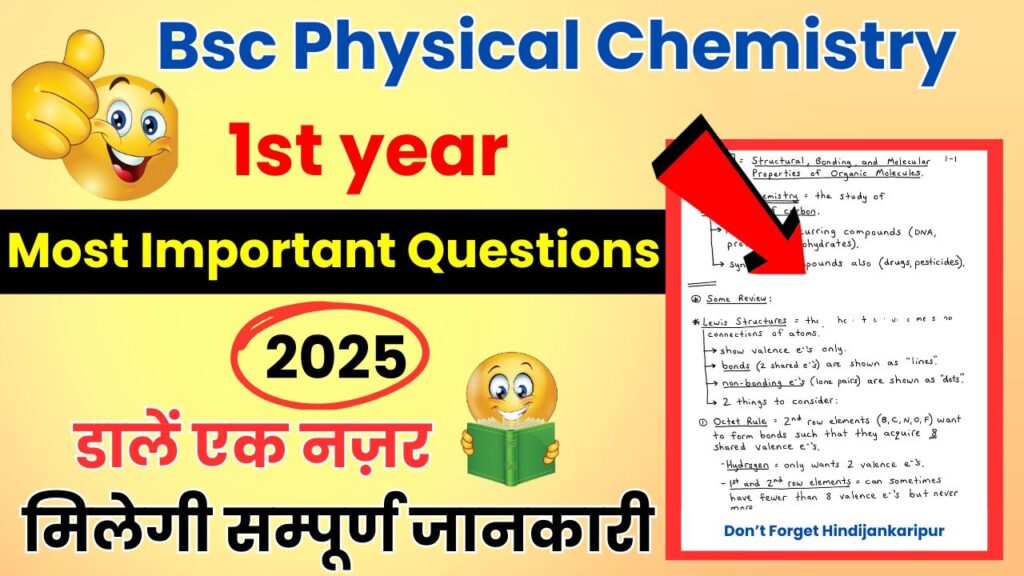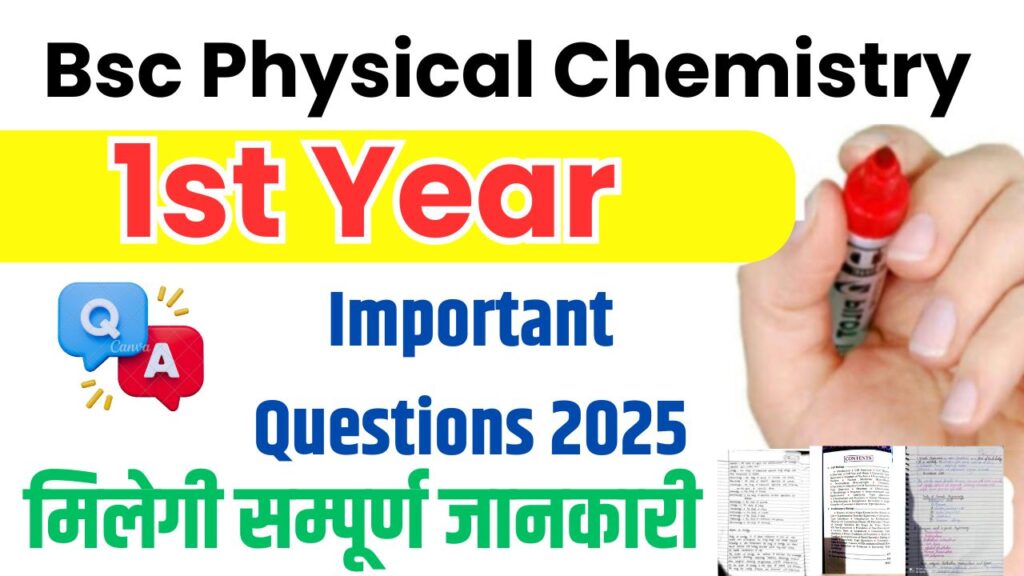नमस्कार साथियों क्या आप जानना चाहते है Bsc 1st year Physical Chemistry Important Questions 2025 के बारे में? दोस्तों आपका स्वागत है इस लेख में, हम आपको BSC 1st Year Organic Chemistry Important Questions in Hindi के साथ Bsc 1st year Physical Chemistry Important Questions 2025 in Hindi, Bsc 1st year Physical Chemistry Important Questions 2025 के बारे में सब कुछ बताएंगे।

जैसा कि आप जानते हैं Chemistry एक बहुत ही दिमाग लगाने वाला subject है, तो इस लेख में हमने Bsc 1st year Physical Chemistry Important Questions 2025 इकट्ठा किया है जो कि आपको पढ़ने में मदत करेंगे अगर आप इस लेख में बताए हुए Important Questions को एक बार रट लेंगे तो आप समझ लो 60% syllabus cover हो जाएगा, तो Bsc 1st year Physical Chemistry Important Questions 2025 की पूरी सूची पढ़ने के लिए इस लेख को अंत तक जरूर पढ़ें ।
यह Bsc 1st year Physical Chemistry Important Questions 2025 के महत्वपूर्ण प्रश्न 2024 प्रतिष्ठित संस्थानों के अनुभवी शिक्षकों द्वारा तैयार किए गए हैं, इन प्रश्नों के पेपर में आने की अधिक संभावना है, इसलिए इन्हें अच्छी तरह से तैयार करें।
Bsc 1st year Physical Chemistry Important Questions 2025

What is the first law of thermodynamics? Explain its significance in chemistry.
(थर्मोडायनेमिक्स का पहला नियम क्या है? रसायन विज्ञान में इसके महत्व को समझाइए।)
Describe the different types of systems in thermodynamics.
(थर्मोडायनेमिक्स में विभिन्न प्रकार की प्रणालियों का वर्णन कीजिए।)
Explain the concept of entropy and its importance in chemical reactions.
(एंट्रोपी की अवधारणा और रासायनिक प्रतिक्रियाओं में इसके महत्व को समझाइए।)
What is Gibbs free energy? How does it predict the spontaneity of a reaction?
(गिब्स मुक्त ऊर्जा क्या है? यह प्रतिक्रिया की स्वतः स्फूर्ति को कैसे दर्शाता है?)
Differentiate between ideal and real gases and explain the van der Waals equation.
(आदर्श और वास्तविक गैसों में अंतर कीजिए और वैन डर वाल्स समीकरण को समझाइए।)
Define chemical equilibrium and explain Le Chatelier’s principle with examples.
(रासायनिक संतुलन को परिभाषित कीजिए और उदाहरणों के साथ ले शेटेलियर सिद्धांत को समझाइए।)
What are colligative properties? Discuss any two with examples.
(कोलिगेटिव गुण क्या हैं? किसी दो का उदाहरण सहित वर्णन कीजिए।)
Explain the concept of partial molar properties with an example.
(आंशिक मोलर गुणों की अवधारणा को उदाहरण सहित समझाइए।)
Discuss the Arrhenius equation and its significance in determining the rate of a chemical reaction.
(आर्रेनीयस समीकरण और रासायनिक अभिक्रिया की दर निर्धारित करने में इसके महत्व पर चर्चा कीजिए।)
Define phase rule and explain its application with a suitable example.
(फेज नियम को परिभाषित कीजिए और किसी उपयुक्त उदाहरण के साथ इसके अनुप्रयोग को समझाइए।)
Describe the laws of photochemistry and their applications.
(प्रकाशरसायन के नियमों का वर्णन कीजिए और उनके अनुप्रयोगों का वर्णन कीजिए।)
What is an electrolyte? Differentiate between strong and weak electrolytes with examples.
(इलेक्ट्रोलाइट क्या है? मजबूत और कमजोर इलेक्ट्रोलाइट में अंतर कीजिए, उदाहरण सहित।)
Explain Raoult’s law and its significance in ideal solutions.
(राउल्ट का नियम और आदर्श विलयन में इसके महत्व को समझाइए।)
What are the different types of adsorption isotherms? Explain the Langmuir adsorption isotherm.
(विज्ञापन आइसोथर्म के विभिन्न प्रकार क्या हैं? लैंगमुइर विज्ञापन आइसोथर्म को समझाइए।)
Explain the kinetic theory of gases and how it describes the behavior of gases.
(गैसों के गतिज सिद्धांत को समझाइए और यह गैसों के व्यवहार को कैसे दर्शाता है।)
Explain the concept of order and molecularity of a reaction with examples.
(प्रतिक्रिया के क्रम और आणविकता की अवधारणा को उदाहरण सहित समझाइए।)
Describe the concept of activation energy and its role in chemical reactions.
(सक्रियण ऊर्जा की अवधारणा और रासायनिक अभिक्रियाओं में इसकी भूमिका को समझाइए।)
What is the difference between endothermic and exothermic reactions? Give examples.
(एंडोथर्मिक और एक्सोथर्मिक प्रतिक्रियाओं में क्या अंतर है? उदाहरण दीजिए।)
Explain the concept of surface tension and its applications in chemistry.
(सतही तनाव की अवधारणा को समझाइए और रसायन विज्ञान में इसके अनुप्रयोगों का वर्णन कीजिए।)
Discuss the Nernst equation and its application in electrochemistry.
(नर्नस्ट समीकरण और इलेक्ट्रोकेमिस्ट्री में इसके अनुप्रयोग पर चर्चा कीजिए।)
What are buffer solutions? Explain their role and give examples.
(बफर विलयन क्या हैं? उनकी भूमिका को समझाइए और उदाहरण दीजिए।)
Define the term ‘enthalpy’ and discuss its significance in thermodynamic processes.
(एनथाल्पी शब्द को परिभाषित कीजिए और थर्मोडायनेमिक प्रक्रियाओं में इसके महत्व पर चर्चा कीजिए।)
Describe the Maxwell-Boltzmann distribution law and its importance in gas behavior.
(मैक्सवेल-बोल्ट्ज़मान वितरण नियम का वर्णन कीजिए और गैसों के व्यवहार में इसके महत्व को समझाइए।)
What is osmotic pressure? Explain its importance in biological and chemical systems.
(आस्मोटिक दबाव क्या है? जैविक और रासायनिक प्रणालियों में इसके महत्व को समझाइए।)
Explain the process of catalysis and distinguish between homogeneous and heterogeneous catalysts.
(उत्प्रेरण की प्रक्रिया को समझाइए और सजातीय और विषमज उत्प्रेरक के बीच अंतर कीजिए।)
Bsc 1st year Physical Chemistry Mutiple Choice Questions

The first law of thermodynamics states that:
- A) Energy can be created and destroyed
- B) Energy can be converted from one form to another
- C) Energy cannot be converted into work
- D) Energy has no effect on chemical reactions
Answer: B) Energy can be converted from one form to another
Explanation: The first law of thermodynamics, also called the law of energy conservation, states that energy cannot be created or destroyed but only transferred or converted from one form to another.
Which of the following is an extensive property?
- A) Temperature
- B) Pressure
- C) Enthalpy
- D) Density
Answer: C) Enthalpy
Explanation: Extensive properties depend on the amount of matter in a system (e.g., enthalpy, mass, volume), while intensive properties (like temperature and pressure) do not.
Which gas law explains the relationship between pressure and volume at constant temperature?
- A) Boyle’s Law
- B) Charles’s Law
- C) Avogadro’s Law
- D) Dalton’s Law
Answer: A) Boyle’s Law
Explanation: Boyle’s Law states that at constant temperature, the volume of a given mass of gas is inversely proportional to its pressure.
In an endothermic reaction:
- A) Heat is absorbed
- B) Heat is released
- C) Temperature increases
- D) There is no heat exchange
Answer: A) Heat is absorbed
Explanation: Endothermic reactions absorb heat from their surroundings, which is why the temperature of the surroundings usually drops.
Raoult’s law is applicable to:
- A) Ideal solutions
- B) Non-ideal solutions
- C) Colloidal solutions
- D) Solid solutions
Answer: A) Ideal solutions
Explanation: Raoult’s law states that the vapor pressure of each component in an ideal solution is directly proportional to its mole fraction.
Which of the following factors does NOT affect the rate of a chemical reaction?
- A) Temperature
- B) Concentration
- C) Catalyst
- D) Pressure (in non-gaseous reactions)
Answer: D) Pressure (in non-gaseous reactions)
Explanation: In non-gaseous reactions, pressure does not significantly impact reaction rates, unlike temperature, concentration, and catalysts.
The pH of a neutral solution at 25°C is:
- A) 0
- B) 7
- C) 14
- D) 10
Answer: B) 7
Explanation: A neutral solution at 25°C has a pH of 7, where the concentrations of H⁺ and OH⁻ ions are equal.
What is the unit of entropy in the SI system?
- A) J/mol
- B) J/K
- C) J/mol·K
- D) J/K·mol
Answer: C) J/mol·K
Explanation: Entropy is measured in joules per mole per Kelvin (J/mol·K), representing the amount of energy dispersal at a specific temperature.
According to Le Chatelier’s Principle, if the concentration of a reactant is increased, the equilibrium will:
- A) Shift to the right (toward products)
- B) Shift to the left (toward reactants)
- C) Remain unchanged
- D) None of the above
Answer: A) Shift to the right (toward products)
Explanation: Increasing the concentration of a reactant shifts the equilibrium towards products to counteract the change, as stated by Le Chatelier’s Principle.
The Van der Waals equation corrects the ideal gas law by accounting for:
- A) Low temperature and low pressure
- B) High temperature and high pressure
- C) Low temperature and high pressure
- D) Ideal gas behavior
Answer: C) Low temperature and high pressure
Explanation: At low temperatures and high pressures, gas molecules experience intermolecular forces and finite volume, which are considered in the Van der Waals equation adjustments.
हमें उम्मीद है कि इस लेख की मदद से आपको Bsc 1st year Physical Chemistry Important Questions 2025 के बारे में जानकारी मिल गई होगी।
दोस्तों आपको यह पोस्ट कैसी लगी कृपया हमें कमेंट सेक्शन में बताएं और यदि आपके कोई प्रश्न हों तो बेझिझक हमसे Comment Box में पूछ सकते हैं। यदि आपको यह पोस्ट उपयोगी लगी तो कृपया इसे दूसरों के साथ साझा करें।